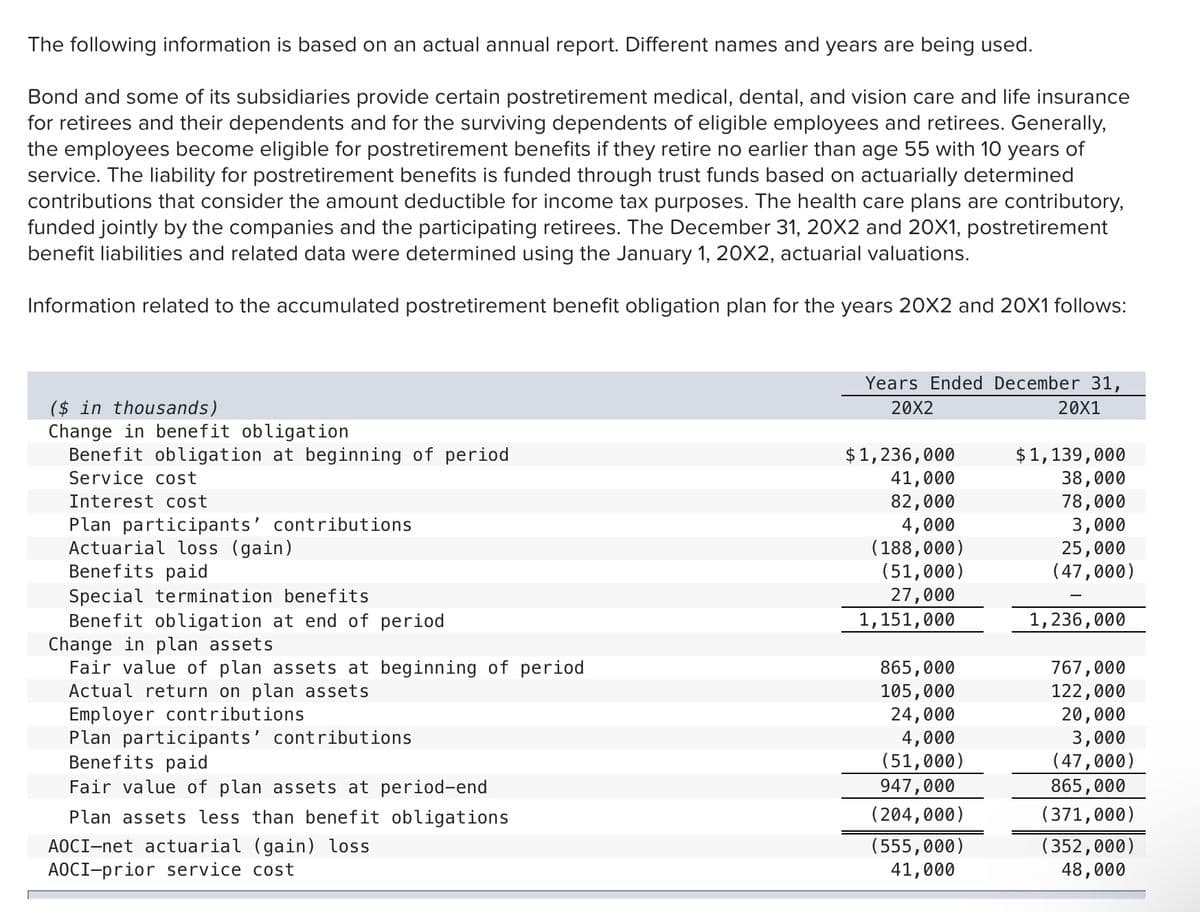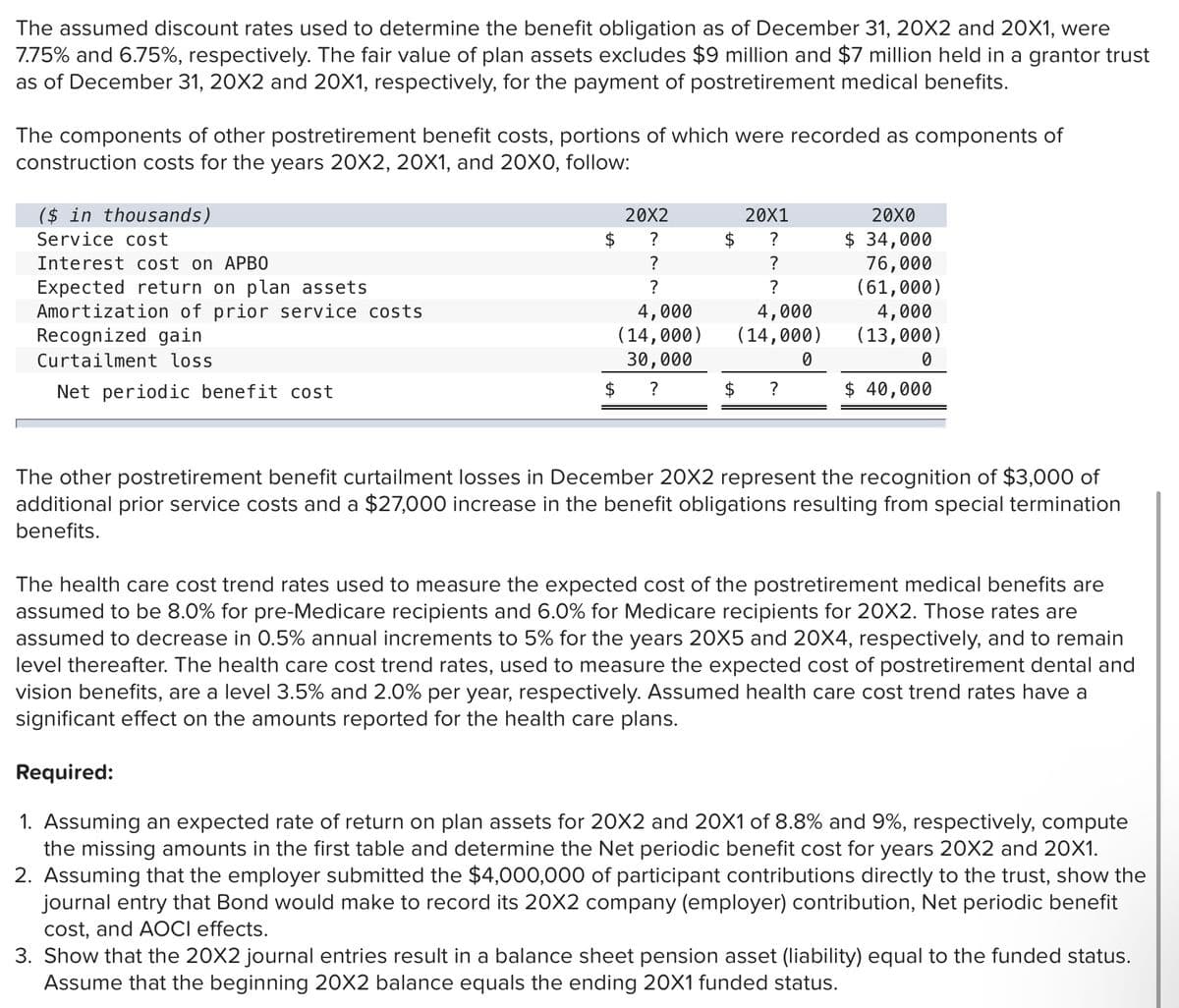The following information is based on an actual annual report. Different names and years are being used. Bond and some of its subsidiaries provide certain postretirement medical, dental, and vision care and life ins for retirees and their dependents and for the surviving dependents of eligible employees and retirees. Gene the employees become eligible for postretirement benefits if they retire no earlier than age 55 with 10 years service. The liability for postretirement benefits is funded through trust funds based on actuarially determine contributions that consider the amount deductible for income tax purposes. The health care plans are contril funded jointly by the companies and the participating retirees. The December 31, 20X2 and 20X1, postretires benefit liabilities and related data were determined using the January 1, 20X2, actuarial valuations. Information related to the accumulated postretirement benefit obligation plan for the years 20X2 and 20X1 f Years Ended Decembe ($ in thousands) Change in benefit obligation 20X2
The following information is based on an actual annual report. Different names and years are being used. Bond and some of its subsidiaries provide certain postretirement medical, dental, and vision care and life ins for retirees and their dependents and for the surviving dependents of eligible employees and retirees. Gene the employees become eligible for postretirement benefits if they retire no earlier than age 55 with 10 years service. The liability for postretirement benefits is funded through trust funds based on actuarially determine contributions that consider the amount deductible for income tax purposes. The health care plans are contril funded jointly by the companies and the participating retirees. The December 31, 20X2 and 20X1, postretires benefit liabilities and related data were determined using the January 1, 20X2, actuarial valuations. Information related to the accumulated postretirement benefit obligation plan for the years 20X2 and 20X1 f Years Ended Decembe ($ in thousands) Change in benefit obligation 20X2
Intermediate Accounting: Reporting And Analysis
3rd Edition
ISBN:9781337788281
Author:James M. Wahlen, Jefferson P. Jones, Donald Pagach
Publisher:James M. Wahlen, Jefferson P. Jones, Donald Pagach
Chapter19: Accounting For Post Retirement Benefits
Section: Chapter Questions
Problem 13E
Related questions
Question

Transcribed Image Text:The following information is based on an actual annual report. Different names and years are being used.
Bond and some of its subsidiaries provide certain postretirement medical, dental, and vision care and life insurance
for retirees and their dependents and for the surviving dependents of eligible employees and retirees. Generally,
the employees become eligible for postretirement benefits if they retire no earlier than age 55 with 10 years of
service. The liability for postretirement benefits is funded through trust funds based on actuarially determined
contributions that consider the amount deductible for income tax purposes. The health care plans are contributory,
funded jointly by the companies and the participating retirees. The December 31, 20X2 and 20X1, postretirement
benefit liabilities and related data were determined using the January 1, 20X2, actuarial valuations.
Information related to the accumulated postretirement benefit obligation plan for the years 20X2 and 20X1 follows:
Years Ended December 31,
($ in thousands)
Change in benefit obligation
Benefit obligation at beginning of period
20X2
20X1
$1,236,000
41,000
82,000
4,000
(188,000)
(51,000)
$1,139,000
38,000
78,000
3,000
25,000
(47,000)
Service cost
Interest cost
Plan participants' contributions
Actuarial loss (gain)
Benefits paid
Special termination benefits
Benefit obligation at end of period
Change in plan assets
Fair value of plan assets at beginning of period
Actual return on plan assets
Employer contributions
Plan participants' contributions
Benefits paid
Fair value of plan assets at period-end
27,000
1,151,000
1,236,000
767,000
122,000
20,000
3,000
(47,000)
865,000
(371,000)
865,000
105,000
24,000
4,000
(51,000)
947,000
(204,000)
Plan assets less than benefit obligations
AOCI-net actuarial (gain) loss
AOCI-prior service cost
(555,000)
41,000
(352,000)
48,000

Transcribed Image Text:The assumed discount rates used to determine the benefit obligation as of December 31, 20X2 and 20X1, were
7.75% and 6.75%, respectively. The fair value of plan assets excludes $9 million and $7 million held in a grantor trust
as of December 31, 20X2 and 20X1, respectively, for the payment of postretirement medical benefits.
The components of other postretirement benefit costs, portions of which were recorded as components of
construction costs for the years 20X2, 20X1, and 20XO, follow:
($ in thousands)
20X2
20X1
20X0
$ 34,000
76,000
(61,000)
4,000
(13,000)
Service cost
?
$
?
Interest cost on APBO
?
Expected return on plan assets
Amortization of prior service costs
Recognized gain
?
?
4,000
(14,000)
30,000
4,000
(14,000)
Curtailment loss
Net periodic benefit cost
$
?
$
?
$ 40,000
The other postretirement benefit curtailment losses in December 20X2 represent the recognition of $3,000 of
additional prior service costs and a $27,000 increase in the benefit obligations resulting from special termination
benefits.
The health care cost trend rates used to measure the expected cost of the postretirement medical benefits are
assumed to be 8.0% for pre-Medicare recipients and 6.0% for Medicare recipients for 20X2. Those rates are
assumed to decrease in 0.5% annual increments to 5% for the years 20X5 and 20X4, respectively, and to remain
level thereafter. The health care cost trend rates, used to measure the expected cost of postretirement dental and
vision benefits, are a level 3.5% and 2.0% per year, respectively. Assumed health care cost trend rates have a
significant effect on the amounts reported for the health care plans.
Required:
1. Assuming an expected rate of return on plan assets for 20X2 and 20X1 of 8.8% and 9%, respectively, compute
the missing amounts in the first table and determine the Net periodic benefit cost for years 20X2 and 20X1.
2. Assuming that the employer submitted the $4,000,000 of participant contributions directly to the trust, show the
journal entry that Bond would make to record its 20X2 company (employer) contribution, Net periodic benefit
cost, and AOCI effects.
3. Show that the 20X2 journal entries result in a balance sheet pension asset (liability) equal to the funded status.
Assume that the beginning 20X2 balance equals the ending 20X1 funded status.
Expert Solution
This question has been solved!
Explore an expertly crafted, step-by-step solution for a thorough understanding of key concepts.
This is a popular solution!
Trending now
This is a popular solution!
Step by step
Solved in 5 steps

Knowledge Booster
Learn more about
Need a deep-dive on the concept behind this application? Look no further. Learn more about this topic, accounting and related others by exploring similar questions and additional content below.Recommended textbooks for you

Intermediate Accounting: Reporting And Analysis
Accounting
ISBN:
9781337788281
Author:
James M. Wahlen, Jefferson P. Jones, Donald Pagach
Publisher:
Cengage Learning



Intermediate Accounting: Reporting And Analysis
Accounting
ISBN:
9781337788281
Author:
James M. Wahlen, Jefferson P. Jones, Donald Pagach
Publisher:
Cengage Learning



Individual Income Taxes
Accounting
ISBN:
9780357109731
Author:
Hoffman
Publisher:
CENGAGE LEARNING - CONSIGNMENT